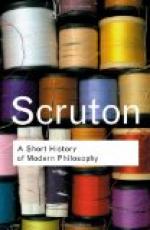By the removal of the thing in itself Aenesidemus-Schulze sought to refute the Kantian theory and Maimon to improve it. Sigismund Beck (1761-1840), in his Only Possible Standpoint from which the Critical Philosophy must be Judged, 1796,[1] seeks by it to elucidate the Kantian theory, holding up idealism as its true meaning. In opposition to the usual opinion that a representation is true when it agrees with its object, he points to the impossibility of comparing the one with the other. Of objects out of consciousness we can know nothing; after the removal of all that is subjective there is nothing positive left of the representation. Everything in it is produced by us; the matter arises together with the form through the “original synthesis.”
[Footnote 1: This book forms the third volume of his Expository Abridgment of the Critical Writings of Professor Kant; in the same year appeared the Outlines of the Critical Philosophy. Cf. on Beck, Dilthey in the Archiv fuer Geschichte der Philosophie, vol. ii., 1889, pp. 592-650.]
The last mentioned attempts to develop the Kantian philosophy were so far surpassed by Fichte’s great achievement that they have received from their own age and from posterity a less grateful appreciation and remembrance than was essentially their due. A phenomenon of a different sort, which is also to be placed at the threshold between Kant and Fichte, but which forms rather a supplement to the noetics and ethics of the latter than a link in the transition to them, has, on the contrary, gained an honorable position in the memory of the German people, viz., Schiller’s aesthetics.[1] In its center stand the Kantian antithesis of sensibility and reason and the reconciliation of the two sides of human nature brought about by its occupation with the beautiful. Artistic activity or the play-impulse mediates between the lower, sensuous matter-impulse and the higher, rational form-impulse, and unites the, two in harmonious co-operation. Where appetite seeks after satisfaction, and where the strict idea of duty rules, there only half the man is occupied; neither lust nor moral worth is beautiful. In order that beauty and grace may arise, the matter-impulse and the form-impulse, or sensibility and reason, must manifest themselves uniformly and in harmony. Only when he “plays” is man wholly and entirely man; only through art is the development of humanity possible. The discernment of the fact that the beautiful brings into equilibrium the two fundamental impulses, one or the other of which preponderates in sensuous desire and in moral volition, does not of itself decide the relative rank of artistic and moral activity. The recognition of this mediating position of art may be connected with the view that it forms a transitional stage toward and a means of education for morality, as well as with the other, that in it human nature attains its completion. Evidence of both views can be found in Schiller’s




